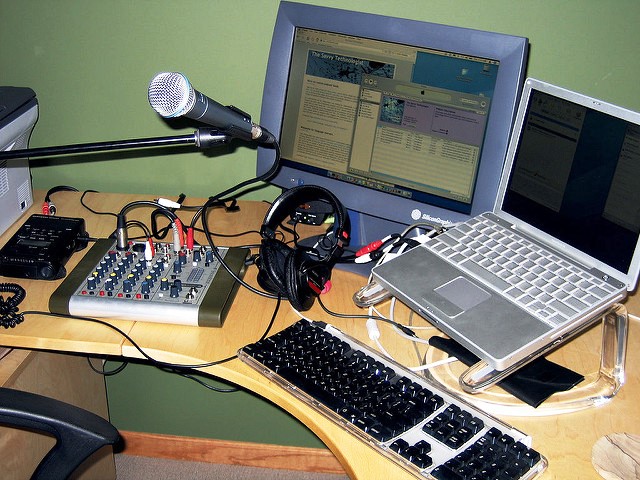
Image source: Tim Wilson via Flickr
Podcasts continue to become more popular. According to the 2018 Infinite Dial study from Edison Research, 44 percent of Americans over 12 years old say they have listened to a podcast, up from 40 percent last year. More than one in five (22 percent) say they most often listen to podcasts in a car, up from 18 percent last year. The survey also reveals that 64 percent listen to online audio monthly, up from 61 percent last year. The slow improvement in podcast listening opens a new PR and marketing channel for brands.
While companies have long advertised on podcasts, more are finding that producing their own podcasts, or branded podcasts, offers an effective PR and marketing strategy. The most successful branded podcasts deliver entertaining, valuable content to the company’s target audience rather than obvious sales pitches.
GE collaborated with Slate’s podcast network Panoply Media to produce The Message, a fictional science-fiction podcast series involving a group of cryptographers investigating mysterious transmissions. It received millions of downloads, and reached number one on the iTunes podcast charts.
Highlights the Brand without Selling
“I don’t consider it advertising. It’s a podcast show that just happens to be produced by a brand instead of a network,” Andy Goldberg, chief creative officer at GE, told Nieman Lab. “I’m not saying, ‘Hey, go out and buy a jet engine.’ It’s a science fiction story to connect listeners with what the GE brand is about, without selling the GE brand.”
Working with podcast content firm Midroll, the job search site ZipRecruiter sponsored the podcast Rise and Grind that analyzes how businesspeople and other professionals work hard to succeed.
“No one wants to listen to a 10-episode podcast about how great ZipRecruiter is at finding a job or helping hire the right applicant,” Lex Friedman, CRO of Midroll, told Fast Company. “But if we can create a show with someone like entrepreneur and author Seth Godin about what it means to be successful and being the most productive person around, that’s going to appeal to exactly the kind of people that ZipRecruiter wants to reach.”
Improved analytics, notably Apple’s analytics for iTunes podcasts, show that most listeners typically listen to the entire program and don’t skip through ads.
The Funding Question
High production costs for podcasts can be a hurdle, which explains why major brands lead the movement. Experts say the costs are competitive with other types of national media campaigns and argue that branded podcasts develop deeper connections with consumers than TV or newspaper ad campaign.
Production costs don’t always need to run into the hundreds of thousands of dollars. Programs that feature one person talking or interviewing a guest are more affordable than those that require traveling around the country and sophisticated sound recordings. Small and medium-size companies that lack budgets for podcast content specialists produce the programs in-house, realizing they might not be as slick. Substantive, useful content with a novel perspective can overcome lack of high-end production.
U.S. Bank understood that its Power of Possible podcast launched last year would initially lack polish. “Our strategy was to get a few episodes produced and get it launched,” said Susan Beatty, U.S. Bank vice president-external communications manager.
Examples to Study
Inbound marketing company BlueWing suggests some first-class branded podcasts marketers can examine and try to emulate:
The Slack Variety Pack covers “work, life, and everything in between” in stories and work-life anecdotes with Slack’s signature quirky and curious sensibility.
Thank God it’s Monday (TGIM) from Shopify addresses its target audience of innovators by telling success stories of entrepreneurs.
Open Account from Umpqua Bank chats about “making, losing, and living with money.”
The Distance from Basecamp offers insights on staying in businesses by focusing on small businesses and mom-and-pop shops that have remained in operation for at least 25 years.
Bottom Line: Branded podcasts offer a fresh and effective strategy for telling the brand’s story and reaching its target audience. More people are listening to podcasts, and improved analytics can reveal if listeners hear key PR and marketing messages. While large brands with deep pockets typically hire podcast studios, small and medium-size companies create podcasts in-house.
William J. Comcowich founded and served as CEO of CyberAlert LLC, the predecessor of Glean.info. He is currently serving as Interim CEO and member of the Board of Directors. Glean.info provides customized media monitoring, media measurement and analytics solutions across all types of traditional and social media.




